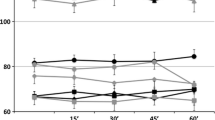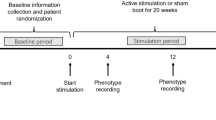Abstract
Invasive vagus nerve stimulation has been demonstrated to be an effective treatment in major depressive episodes. Recently, a novel non-invasive method of stimulating the vagus nerve on the outer canal of the ear has been proposed. In healthy subjects, a prominent fMRI BOLD signal deactivation in the limbic system was found. The present pilot study investigates the effects of this novel technique of auricular transcutaneous electric nerve stimulation in depressed patients for the first time. A total of 37 patients suffering from major depression were included in two randomized sham controlled add-on studies. Patients were stimulated five times a week on a daily basis for the duration of 2 weeks. On days 0 and 14, the Hamilton Depression Rating Scale (HAMD) and the Beck Depression Inventory (BDI) were assessed. In contrast to sham-treated patients, electrically stimulated persons showed a significantly better outcome in the BDI. Mean decrease in the active treatment group was 12.6 (SD 6.0) points compared to 4.4 (SD 9.9) points in the sham group. HAMD score did not change significantly in the two groups. An antidepressant effect of a new transcutaneous auricular nerve stimulation technique has been shown for the first time in this controlled pilot study. Regarding the limitations of psychometric testing, the risk of unblinding for technical reasons, and the small sample size, further studies are necessary to confirm the present results and verify the practicability of tVNS in clinical fields.



Similar content being viewed by others
References
American Psychiatric Association (2000) Diagnostic and statistical manual of mental disorders, 4th edn., text revision. APA Press, Washington, DC
Avery D, Winokur G (1977) The efficacy of electroconvulsive therapy and antidepressants in depression. Biol Psychiatry 12(4):507–523
Bajbouj M, Merkl A, Schlaepfer TE, Frick C, Zobel A, Maier W et al (2010) Two-year outcome of vagus nerve stimulation in treatment-resistant depression. J Clin Psychopharmacol 30(3):273–281
Beck AT, Ward CH, Mendelson M, Mock J, Erbaugh J (1961) An inventory for measuring depression. Arch Gen Psychiatry 4:561–571
Berthoud HR, Neuhuber WL (2000) Functional and chemical anatomy of the afferent vagal system. Auton Neurosci. 85(1–3):1–17
Bewernick BH, Hurlemann R, Matusch A, Kayser S, Grubert C, Hadrysiewicz B et al (2010) Nucleus accumbens deep brain stimulation decreases ratings of depression and anxiety in treatment-resistant depression. Biol Psychiatry 67(2):110–116
Bystritsky A, Kerwin L, Feusner J (2008) A pilot study of cranial electrotherapy stimulation for generalized anxiety disorder. J Clin Psychiatry 69(3):412–417
Daban C, Martinez-Aran A, Cruz N, Vieta E (2008) Safety and efficacy of Vagus Nerve Stimulation in treatment-resistant depression. A systematic review. J Affect Disord 110(1–2):1–15
Daskalakis ZJ, Levinson AJ, Fitzgerald PB (2008) Repetitive transcranial magnetic stimulation for major depressive disorder: a review. Can J Psychiatry 53(9):555–566
Dietrich S, Smith J, Scherzinger C, Hofmann-Preiss K, Freitag T, Eisenkolb A et al (2008) A novel transcutaneous vagus nerve stimulation leads to brainstem and cerebral activations measured by functional MRI. Biomed Tech (Berl) 53(3):104–111
Fallgatter AJ, Neuhauser B, Herrmann MJ, Ehlis AC, Wagener A, Scheuerpflug P et al (2003) Far field potentials from the brain stem after transcutaneous vagus nerve stimulation. J Neural Transm. 110(12):1437–1443
Fallgatter AJ, Ehlis AC, Ringel TM, Herrmann MJ (2005) Age effect on far field potentials from the brain stem after transcutaneous vagus nerve stimulation. Int J Psychophysiol 56(1):37–43
Fitzgerald PB, Benitez J, de Castella A, Daskalakis ZJ, Brown TL, Kulkarni J (2006) A randomized, controlled trial of sequential bilateral repetitive transcranial magnetic stimulation for treatment-resistant depression. Am J Psychiatry 163(1):88–94
Frank E, Eichhammer P, Burger J, Zowe M, Landgrebe M, Hajak G et al (2010) Transcranial magnetic stimulation for the treatment of depression: feasibility and results under naturalistic conditions: a retrospective analysis. Eur Arch Psychiatry Clin Neurosci 261(4):261–266
Greif R, Laciny S, Mokhtarani M, Doufas AG, Bakhshandeh M, Dorfer L et al (2002) Transcutaneous electrical stimulation of an auricular acupuncture point decreases anesthetic requirement. Anesthesiology 96(2):306–312
Hamilton M (1960) A rating scale for depression. J Neurol Neurosurg Psychiatry 23:56–62
Kessler RC, Birnbaum HG, Shahly V, Bromet E, Hwang I, McLaughlin KA et al (2010) Age differences in the prevalence and co-morbidity of DSM-IV major depressive episodes: results from the WHO World Mental Health Survey Initiative. Depress Anxiety 27(4):351–364
Kraus T, Hösl K, Kiess O, Schanze A, Kornhuber J, Forster C (2007) BOLD fMRI deactivation of limbic and temporal brain structures and mood enhancing effect by transcutaneous vagus nerve stimulation. J Neural Transm. 114(11):1485–1493
Lampl C, Kreczi T, Klingler D (1998) Transcutaneous electrical nerve stimulation in the treatment of chronic pain: predictive factors and evaluation of the method. Clin J Pain 14(2):134–142
Loo CK, Sachdev P, Martin D, Pigot M, Alonzo A, Malhi GS et al (2010) A double-blind, sham-controlled trial of transcranial direct current stimulation for the treatment of depression. Int J Neuropsychopharmacol 13(1):61–69
Luijpen MW, Swaab DF, Sergeant JA, Scherder EJ (2004) Effects of transcutaneous electrical nerve stimulation (TENS) on self-efficacy and mood in elderly with mild cognitive impairment. Neurorehabil Neural Repair. 18(3):166–175
Marangell LB, Martinez M, Jurdi RA, Zboyan H (2007) Neurostimulation therapies in depression: a review of new modalities. Acta Psychiatr Scand 116(3):174–181
Polak T, Ehlis AC, Langer JB, Plichta MM, Metzger F, Ringel TM et al (2007) Non-invasive measurement of vagus activity in the brainstem: a methodological progress towards earlier diagnosis of dementias? J Neural Transm. 114(5):613–619
Polak T, Markulin F, Ehlis AC, Langer JB, Ringel TM, Fallgatter AJ (2009a) Far field potentials from brain stem after transcutaneous vagus nerve stimulation: optimization of stimulation and recording parameters. J Neural Transm. 116(10):1237–1242
Polak T, Markulin F, Ehlis AC, Metzger F, Langer JB, Ringel TM et al (2009b) Auricular vagus somatosensory evoked potentials in vascular dementia. J Neural Transm. 116(4):473–477
Sackeim HA, Rush AJ, George MS, Marangell LB, Husain MM, Nahas Z et al (2001) Vagus nerve stimulation (VNS) for treatment-resistant depression: efficacy, side effects, and predictors of outcome. Neuropsychopharmacology 25(5):713–728
Scherder EJ, Van Someren EJ, Bouma A, vd Berg M (2000) Effects of transcutaneous electrical nerve stimulation (TENS) on cognition and behaviour in aging. Behav Brain Res 111(1–2):223–225
Schlaepfer TE, Frick C, Zobel A, Maier W, Heuser I, Bajbouj M et al (2008) Vagus nerve stimulation for depression: efficacy and safety in a European study. Psychol Med 38(5):651–661
Shelton RC, Osuntokun O, Heinloth AN, Corya SA (2010) Therapeutic options for treatment-resistant depression. CNS Drugs. 24(2):131–161
Shern DL, Moran H (2009) STAR*D: helping to close the gap between science and practice. Psychiatr Serv 60(11):1458–1459
Stegmann ME, Ormel J, de Graaf R, Haro JM, de Girolamo G, Demyttenaere K et al (2010) Functional disability as an explanation of the associations between chronic physical conditions and 12-month major depressive episode. J Affect Disord 124(1–2):38–44
Ventureyra EC (2000) Transcutaneous vagus nerve stimulation for partial onset seizure therapy. A new concept. Childs Nerv Syst. 16(2):101–102
World Health Organization (1992) The ICD-10 classification of mental and behavioural disorders: Clinical descriptions and diagnostic guidelines. World Health Organization, Geneva
Zobel A, Joe A, Freymann N, Clusmann H, Schramm J, Reinhardt M et al (2005) Changes in regional cerebral blood flow by therapeutic vagus nerve stimulation in depression: an exploratory approach. Psychiatry Res 139(3):165–179
Author information
Authors and Affiliations
Corresponding author
Rights and permissions
About this article
Cite this article
Hein, E., Nowak, M., Kiess, O. et al. Auricular transcutaneous electrical nerve stimulation in depressed patients: a randomized controlled pilot study. J Neural Transm 120, 821–827 (2013). https://doi.org/10.1007/s00702-012-0908-6
Received:
Accepted:
Published:
Issue Date:
DOI: https://doi.org/10.1007/s00702-012-0908-6




